Beretta’s APX isn’t their first striker-fired pistol, but it still feels like a new direction for the company. What’s not new to the APX line is the company’s focus on blending style and ergonomics. You can spot an APX several shooting lanes away by the distinctive slide serration pattern. Actually, it’s not really even serrated. The slides are populated with subtle vertical ridges down the length of both sides. That provides grip for loading, unloading, and malfunction clearance. Yes, they look distinctive, but after using a couple of APX’s for the past month, I kind of like them.
The APX was born out of the Army’s Modular Handgun trials. Manufacturers came out with new pistols and revisions of existing models in their efforts to win the lucrative contract to equip the United States Military with 74 boatloads of new handguns to replace the Beretta M9 series now in service.
As we all now know, the Sig Sauer P320 won the military’s handgun contract, so competing companies were left with entries sitting on the shelf just ready for the consumer market. I’m sure that’s no surprise for the entrants of the MHS trials, and it’s a sure bet that they all planned to release their designs to the commercial market win or lose. In Beretta’s case, they’ve created a family of APX pistols that are now all available in the commercial market.
APX RDO
While I requested the RDO model for review, we can compare it directly to the standard APX as the models are identical except for the optics mount cutout on the slide and included mounting plates. We’ll come back to that later, just know that for now, we’ll refer to the standard features of the two pistols generically. There are some very small dimension and weight differences. For example, the standard APX model is 0.05 inches longer for some reason. The RDO also weighs in at 33.3 ounces while the standard APX is 28.24 oz.

The Beretta APX RDO is virtually identical to the standard except for the slide cutout and optics mounting plates.
Capacity of both the APX and APX RDO is 17+1 for 9mm and 15+1 for .40 S&W.
APX Compact
New for 2018 is the APX Compact. In my subjective opinion, it lives between what most people call the subcompact and compact categories. Its 3.7-inch barrel fits into an overall length, height and width package of 6.97 x 4.8 x 1.3 inches. That width measurement is a bit deceiving, however. While the widest part of the grip does hit the 1.3-inch mark, it narrows significantly as towards the top. This is a good thing not only because it feels much more slender, but also because that slimmer area helps your trigger finger reach unhindered.
The compact model packs 13+1 rounds of 9mm. If you elect to get the .40 S&W version, the capacity is 10+1.
APX Centurion
Another new entry for 2018 is the APX Centurion. As I write this, they just started shipping, so I don’t have one in my hands yet, but for performance comparison, it should be nearly identical to the APX Compact. Here are the differences.
The 3.7-inch barrel is the same as on the Compact model, so it’s the grip height and therefore capacity that differs. The Centurion is 5.1 inches tall, compared to 4.8 inches for the Compact. The goal was to provide a more compact pistol that the full-size duty APX that keeps the same handling characteristics. Yes, the full-size model is 5.3 inches high, but I was still able to easily get all my fat fingers on the Centurion when I handled one at this year’s NRA Annual Meeting and Expo. On the APX Compact, about half of my pinky hangs in the air under the magazine floor plate.
Due to the height difference from the compact, capacity is more in the Centurion. It holds 15 rounds of 9mm in the magazine and 13 of .40 S&W.
Modular Fire Control System
The APX pistols are built around a removable and serialized internal chassis. As that’s the serialized part, that defines the gun itself. So, if you have the chassis, you can order a replacement frame, slide, or barrel with no federal legal issues. To me, this feature has always been more practically relevant to agencies and armorers responsible for dealing with dozens, hundreds, or thousands of guns and configurations, but it’s available if you care. In the individual case, the feature would allow you to convert a Compact to a Centurion of vice versa. If you want to convert between those models and a full size, you’d also need to swap out the barrel and slide assembly. The other use case would be a simple frame color change. As I write this, the company offers standard size replacement frames in Wolf Gray, Olive Drab, and Flat Dark Earth colors on their website for $50.

Technically speaking, the actual “firearm” is the fire control chassis. They’re identical in the two pistols shown here and can be paired with different frames, slides, and barrels.
Triggers
Having both pistols here it was easy to compare the triggers, in detail, side by side.
The APX RDO pistols trigger broke consistently at 4 ½ pounds. It has 1/8th of an inch of smooth take-up followed by another 1/8th of an inch of pressure until it breaks. I couldn’t detect any stacking before the break, so it does offer a decent surprise break. Indeed, as you get used to the pistol, you’ll know when it’s about to fire. It’s just not easily detectable by feel. The reset happens after ¼” of forward travel and is easy to feel as well as audibly clear.
The APX Compact shown here has a slightly heavier trigger. I measured it at a consistent 5 ¼ pounds of pressure. Everything else including the take-up, break, feel, and reset was identical to that of the full-size APX RDO. As the fire control systems in each pistol are identical, the weight difference stumped me a bit. When I hold them side by side, there’s a bit more weight in the take-up of the Compact, so perhaps it’s just a bit of extra friction from the different frame.
All in all, the triggers on both guns are pretty solid. While not “glass rod” crisp, they’re not mushy either like some other polymer service pistols. I wouldn’t be rushing out to do an upgrade or trigger job if this was my daily carry gun.
Grips
All of the different APX models come with replaceable backstraps in small, medium, and large sizes. Given the slender feel, I installed the large backstraps on both pistols. While I don’t have huge hands, I wear a size large glove if that provides any frame of reference for you.
Changing the backstraps is easy enough but read the instructions first before you start tugging on the locking bar at the bottom of the magazine well. There’s a “catch” up towards the top of the well that you slide sideways before you can remove that locking bar from the bottom. Ask me how I know… Hey, you can’t really expect me to read instructions first, can you? I’m only human…
You’ll see a subtle difference between the APX and APX Compact on the grip itself. The big one has very subtle finger grooves. I’ve always liked those, but I get why others don’t. It’s a personal preference for sure. I would note that they are very low profile on the APX and not nearly as pronounced as on earlier Glocks. If you’re not a finger groove fan, you might not hate these as they really don’t get in the way. With that said, the Compact doesn’t have any – the front of the grip is flat and features a much more aggressive texture than that of the APX RDO. The backstrap surfaces feel identical to me on both pistols.

The widest part of the grip is 1.3 inches, but it feels much more slender thanks to the inward taper near the top.
Controls
Owing to its Modular Handgun System Trials roots, the APX pistols have ambidextrous operating controls. The slide locks are on both sides of the frame already – no need to switch if you’re a lefty. They’re also low profile, and there’s a cutout in the frame for each. That keeps them out of the way, but they’re still easy enough to operate with the firing hand thumb. Even the Compact has a workable slide lock, and that’s not always a given with smaller pistols given the heavier spring tension of smaller pistols.
The magazine release is prominent on both pistols and extends out from the frame, making it easy to drop a mag with your firing hand thumb. It comes from the factory on the left side but is easily reversible. Speaking of magazines, those included with APX models are sweet. They’re made of steel, drop freely when desired, and feature generous floorplates that can be ripped out of the well if all goes sideways.
The takedown lever isn’t reversible, nor does it need to be since it’s a purely administrative function. It’s a little bit like that of the 92 series but more secure. To field strip the pistol, you push a large button into the right side of the frame. That extends a rotating lever a bit out of the left side, at which point you can turn it 90 degrees and remove the slide. You can either depress the trigger before doing this using a safe backstop or you can release the sear using a recessed button on the rear right side of the frame. To do that, pull the slide back a half-inch or so and press the button in until you hear a click. Then proceed to field strip the pistol as normal.
Operating Safeties
The standard configuration of the APX pistols is much like that of Glocks and other service pistols. There’s a trigger leaf in the center of the trigger face that has to be depressed before the trigger can be moved. There’s a striker block that prevents forward movement of the striker unless the trigger is pressed fully. There’s also an out of battery mechanism which keeps the trigger bar disconnected and inoperable until the slide and barrel are locked up tight. According to the company, the pistols are orderable with three other types of safety devices: a manual thumb safety, a magazine disconnect, and a loaded chamber indicator. It’s not yet clear whether these alterations will be available to the retail market or whether those modifications are only available for larger agency orders.
Sights
At long last, the days of the “fixed” front sight of the Beretta 92 and M9 pistols are over! I’ve always been a fan of those pistols, but the inability to swap out the front sight has been a major bummer. The APX uses standard dovetails for front and back sight mounting. From the factory, you’ll get steel sight housings with bright white dots. If you want something else, no problem, they’re easy enough to change.
Shooting the APX RDO and APX Compact
Out of habit, I applied a couple of drops of Slip2000 EWL to the slide rails and went to the range with an assortment of 9mm full metal jacket and defensive hollow-point ammunition. Make that several range trips. So far, I’ve put several hundred rounds of mixed ammo through each pistol and have had zero malfunctions with any ammo type – FMJ or hollow-point – in either pistol.
Like nearly every Beretta I’ve shot, both of these 9mm pistols are soft shooting. Sure, the relatively tame 9mm caliber helps, but that’s more a reflection of overall ergonomics. The shape of the frame allows lots of hand to gun surface area contact, so it’s easy to control.
As far as pointing, if you like the grip angle of the Glock, you’ll probably be right at home with the APX. The actual measured angle of the grip seems more similar to that of a 1911, but the generous cutout at the top of the backstrap that allows you to get your hand right under the bore axis seems to have the effect of making the grip angle feel slightly more rakish like the Glock. That varies a bit depending on your hand and which backstrap you choose, so don’t count that as a generalization.
Since the RDO has a place for an optic, I felt compelled to add one. Because fun. Using one of the included four adapter plates, I easily installed a Trijicon RMR red dot sight. I should also note here that Beretta includes a variety of screws of different lengths to assist with mounting different brands of red dot sights. On another brand of optics-ready pistol, I had to source just the right screws separately, so the fact that they were included here was a nice touch.
Anyway, I was having good ol’ time with the RDO, so I shot lots of groups with a wide variety of ammo. Here’s what I measured for five-shot groups from a distance of 25 yards.
| Ammunition | Group Size (5 shots, 25 yards) |
| Blazer 9mm 115 grain | 1.45” |
| Speer Gold Dot +P 9mm 124 grain | 2.5” |
| Federal HST 9mm 124 grain | 2.32” |
| Sig Sauer V-Crown 9mm 124 grain | 1.73” |
| Sig Sauer FMJ 9mm 115 grain | 1.97” |
| Barnes TAC-XPD +P 9mm 115 grain | 1.75” |
| American Eagle Syntech 9mm 115 grain | 3.86” |
| American Eagle FMJ 9mm 124 grain | 2.34” |
| Sig Sauer V-Crown 9mm 115 grain | 1.94” |
Not wanting to be unfair with accuracy testing by relying on my aging eyes and iron sights for the Compact model, I mounted a Bushnell Elite 3500 Handgun Scope to it using the UM Tactical Rail Mount System. While it looked a bit silly on the APX Compact, it did allow me to achieve a perfect sight picture and hold at 25 yards. I did shoot these groups on a different day so ammo types vary and I didn’t burn through quite as much ammo as on my previous outing with the RDO. Here’s what I measured for five-shot groups from that distance.
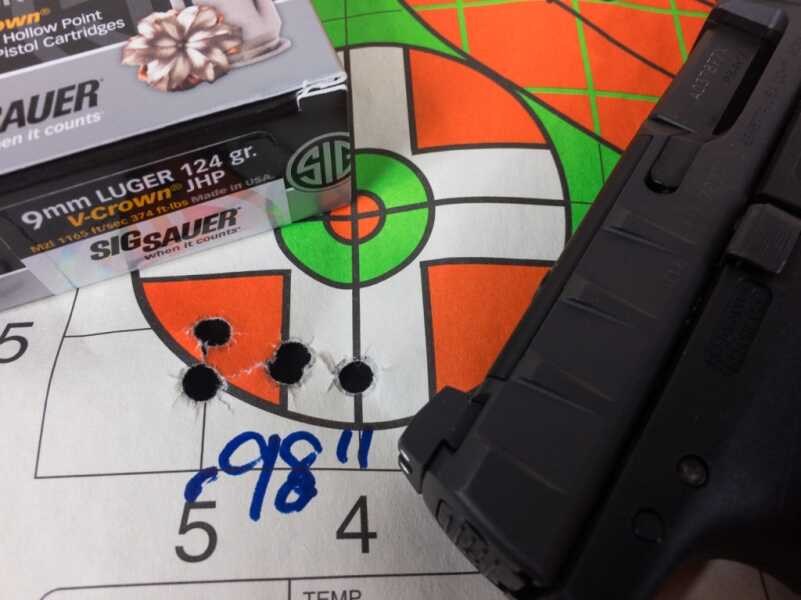
The APX RDO turned in some impressive groups like these five shots of Sig Sauer V-Crown from 25 yards.
| Ammunition | Group Size (5 shots, 25 yards) |
| Federal HST 9mm 124 grain | 1.57” |
| American Eagle Syntech 9mm 115 grain | 3.85” |
| Sig Sauer V-Crown 9mm 115 grain | 2.55” |
| Sig Sauer 365 V-Crown 9mm 115 grain | 2.94” |
| Sig Sauer 365 FMJ 9mm 115 grain | 3.35” |
Closing Arguments
We have a lot of utterly reliable choices these days when it comes to selecting a polymer service pistol. Both of these ran like champs and shot plenty accurate enough to meet most requirements. As for price, the MSRP for the standard full-sized APX, Compact, and Centurion is $575. The APX RDO with slide cutout and mounting plates carries an MSRP of $725.
Visit Beretta’s website for more information on the APX by clicking here.

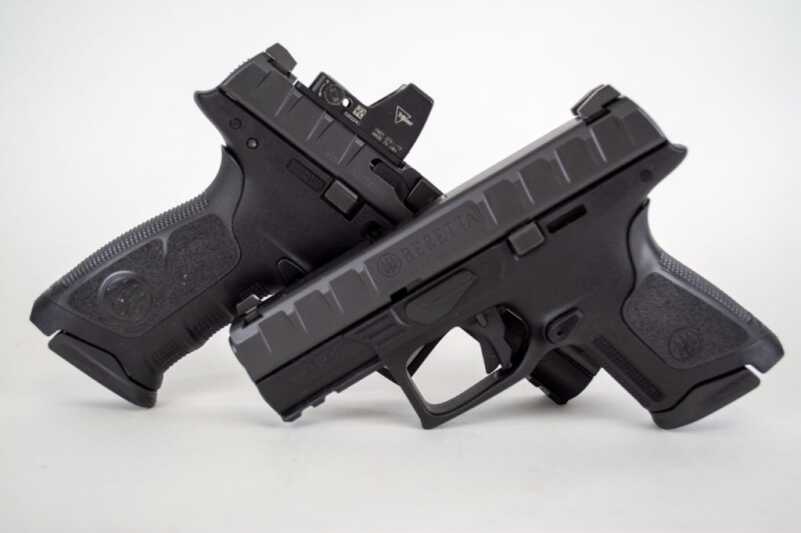

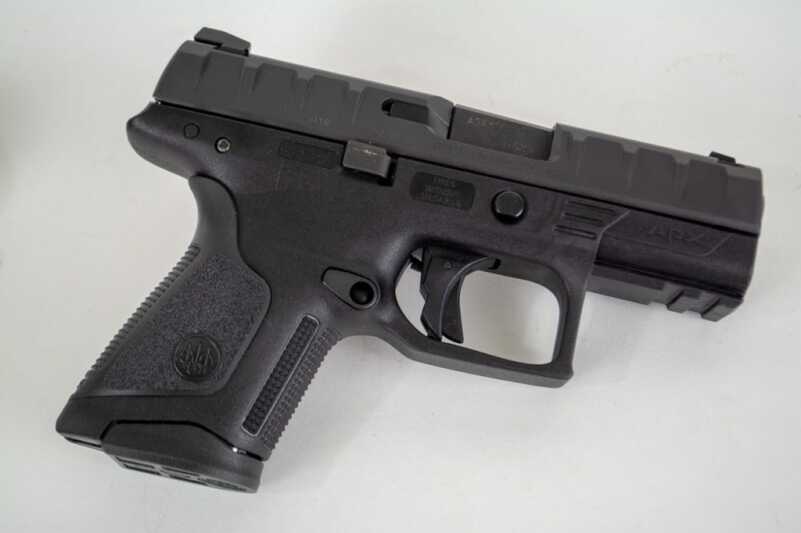

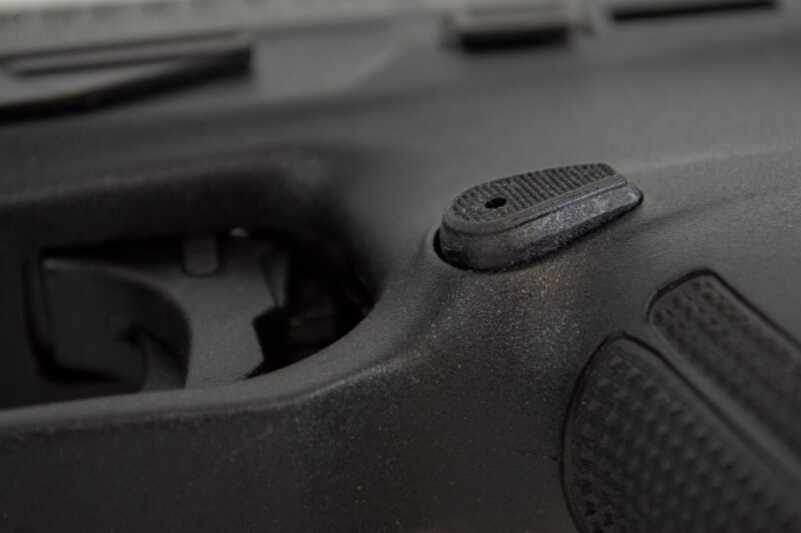
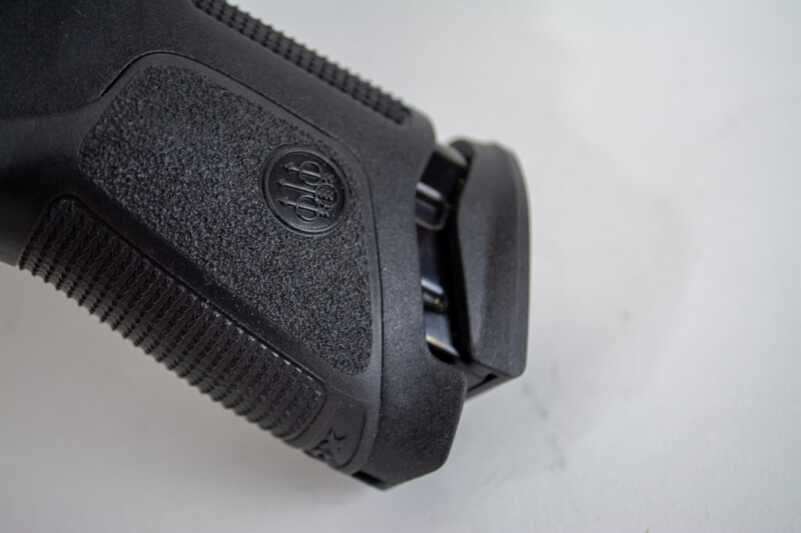

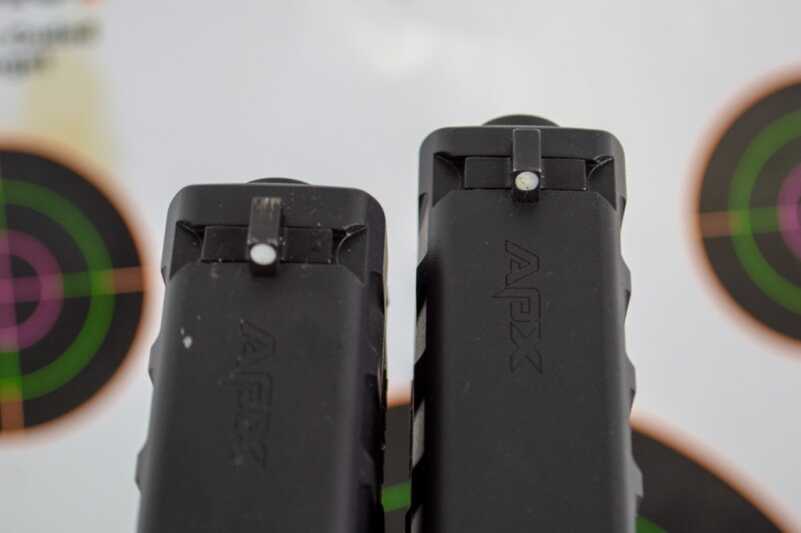
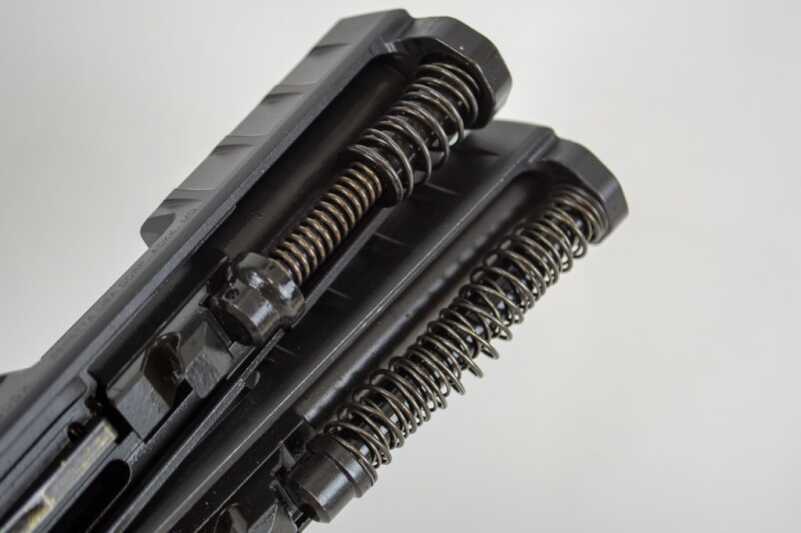
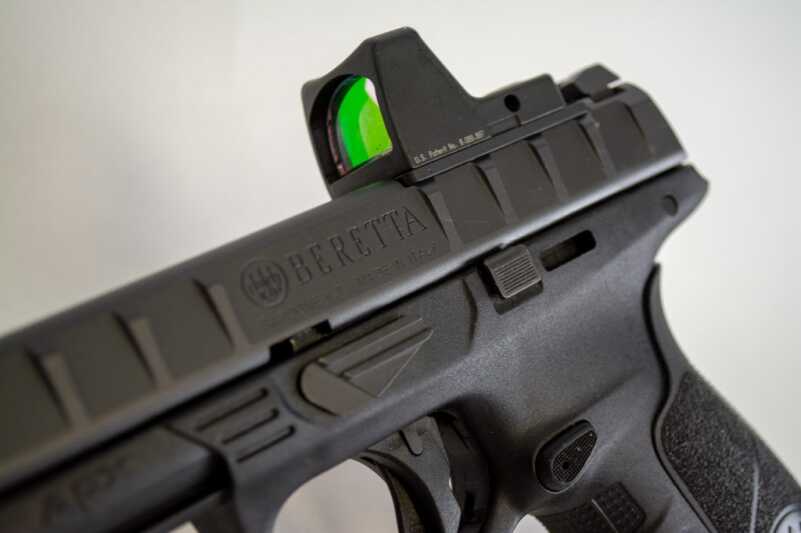
While I do have two Glocks among my handguns, I still haven’t figured out exactly why the trend has been and remains to make the slide of polymer guns square. Why not give them a better shape that is less blocky, takes up less room and is both more ergonomic and more appealing.
Is it cheaper to manufacture? An easier shape for CNC milling machines to handle? I personally would prefer a rounded or other shape that doesn’t look like a stick of black butter. Ruger has better shaped slides than most, they just need to step up their accuracy. I’m a little old school I guess but the 1911 slide shape just make more sense although there other more modern shapes I like, just not the butter sticks.
Take a look at the CZ P10 searies of pistols. Lovely sculpted slides and legendary CZ build quality and accuracy…
I want to thank you for the great photos in this article, they were a better style / angle / alignment then I have seen in other articles, and helped me understand what I’m looking at. (seeing the flair on the mag bottom) the angle of the picture made it standout more so I could see what was being pointed out. Well done and thank you.
I see from the article that no 147 grain ammo was tested, any reason why? In testing a handgun I would think all different ammunition would be used especially with today’s science behind much of the ammunition made today! I have always preferred to shoot the heaviest grain ammo I can get for self defense, an old tactic taught many years ago! To each their own I suppose!